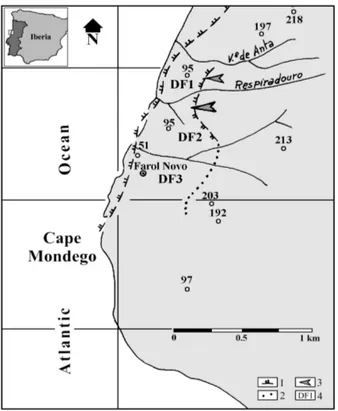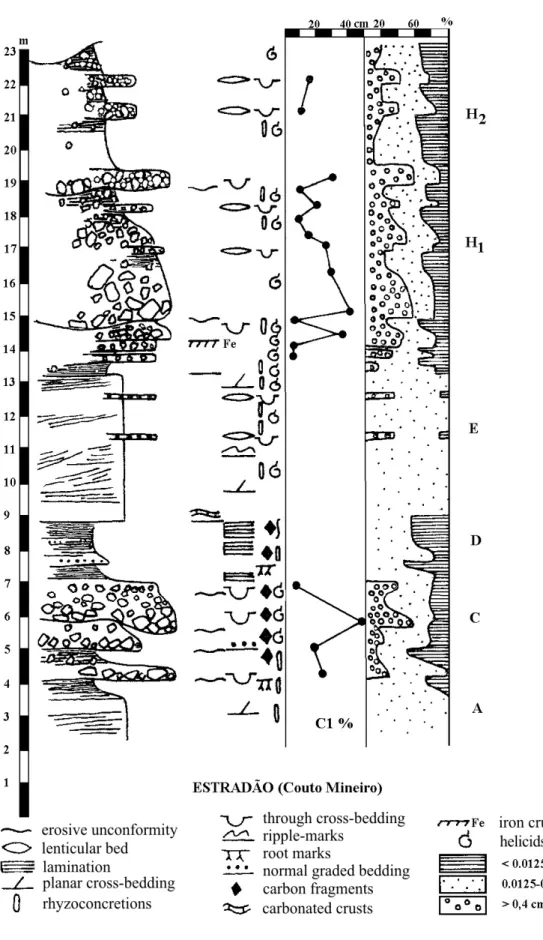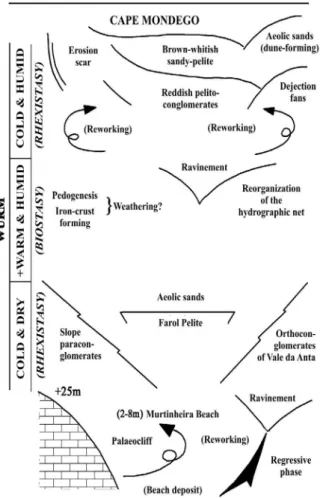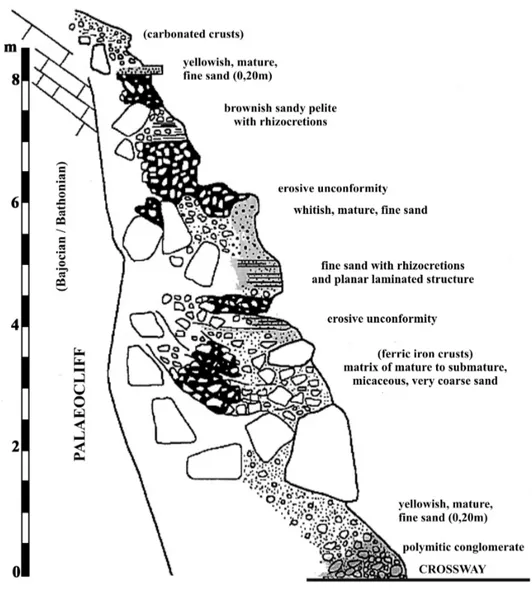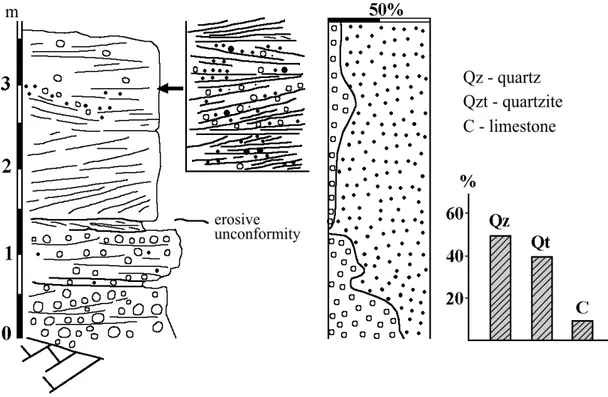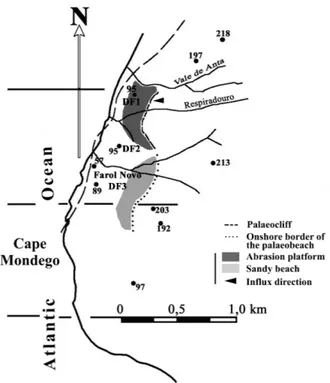The Farol Deposit (
Depósito do Farol
) – a Pleistocene beach deposit
from Cape Mondego (Figueira da Foz, West Central Portugal)
*A. Ferreira Soares
1, P. M. Callapez
2,3& J. Fonseca Marques
41 Rua General Humberto Delgado 82, 12º Dto., 3030-327 Coimbra 2
Departamento de Ciências da Terra da Universidade de Coimbra, Largo Marquês de Pombal, 3000-272 Coimbra, Portugal; zepallac @ gmail.com
3 Centro de Geofísica da Universidade de Coimbra
4Museu Mineralógico e Geológico da Universidade de Coimbra, 3000-272 Coimbra; juliofmarques@gmail.com
Resumo
Palavras-chave: Cabo Mondego, Depósito do Farol, conglomerado polimítico, areias, fanglomerado calclitítico, praia, paleofalésia, Plistocénico Inferior/Médio
Entre os depósitos quaternários do Cabo Mondego (Serra da Boa Viagem) destaca-se, a uma altitude cerca dos 95 m, o
“Depósito do Farol” representado em três afloramentos por conglomerados e areias, interstratificados e sobrepostos por fanglomerados calclitíticos. No conjunto, traduzem acumulação em ambiente de praia na dependência de falésia adjacente.
A fauna, de onde se destacam pela sua abundância relativa as espécies Nucella lapillus (LINNÉ, 1758), Patella vulgata (LINNÉ, 1758) e Littorina littorea (LINNÉ, 1758), indica-nos não só águas mais frias que as observadas na costa actual de Portugal, como aponta para associações ligadas a plataformas rochosas do andar médio-litoral, periodicamente expostas e sujeitas às acções da rebentação e surf.
No seu todo, o “Depósito do Farol” corresponde a episódio do Plistocénico Inferior/Médio, anterior aos Estádios Isotópicos 7 e 11, representativos do apogeu de aquecimento do Plistocénico Médio. Deste modo, a sua génese deverá ser anterior à deposição dasAreias de Quiaios e Areias de Cantanhede (Siciliano?), mas posterior às Areias de Arazede e Areias de Marinha das Ondas (Plistocénico Inferior).
Résumé
Mots-clés: Cap Mondego, Dépôt du Phare, conglomérat polygénique (polymictite), sables, fanglomérat calclititique, plage, palaeo-falaise, Pleistocène Inférieur/Moyen
Parmi les dépôts pléistocènes et holocènes du Cap Mondego (Serra da Boa Viagem, Figueira da Foz, Portugal) ont trouve, vers une altitude proche de 95 m, le «Dépôt du Phare» (Depósito do Farol), représenté par trois affleurements avec des conglomérats et des sables, interstratifiés et superposés par des fanglomérats calclititiques. Cette succession traduit une
accumulation sédimentaire dans un ambient de plage, placé au voisinage d’une falaise.
Ce dépôt a fourni une faune subfossile très intéressante, avec des débris et des coquillages embrasés de Nucella lapillus (LINNÉ, 1758), Patella vulgata (LINNÉ, 1758) et Littorina littorea (LINNÉ, 1758). Cet ensemble suggère l'existence d'un paléoenvironnement avec des eaux de surface plus froides que celles de la côte actuel du Portugal. L´association faunistique est aussi liée à des plate-formes rocheuses de la partie moyenne du milieu intertidal, périodiquement exposées à l'action dynamique des vagues.
Dans l’ensemble, le «Dépôt du Phare» correspond à un épisode du Pleistocène Inférieur/Moyen, avec un âge antérieur aux Stades Isotopiques 7 et 11, corrélatifs des phases chaudes du Pleistocène Moyen. Par conséquent, la genèse du dépôt doit être antérieure à la déposition des Sables de Quiaios et des Sables de Cantanhede (Sicilien?), mais aussi postérieure aux Sables de Arazede et Sables de Marinha das Ondas (Pleistocène Inférieur).
_______________
Abstract
Key-words:Cape Mondego, Farol Deposit, polymitic conglomerate, sands, calclititic fanglomerate, beach, palaeocliff, Lower/Middle Pleistocene
Among the Pleistocene and Holocene units recorded near the marine cliffs of Cape Mondego (Figueira da Foz, West Central Portugal) stands out the Farol Deposit (Depósito do Farol), at an altitude of ±95 m above present sea level. It is a marine terrace with three exposures of interstratified conglomerates and sands, overlapped by calclititic-fanglomerates. This sedimentary setting indicates that deposition took place in a seashore environment influenced by the proximity of a marine palaeocliff.
The deposit has an interesting subfossil fauna with abraded and fragmented shells of Nucella lapillus (LINNÉ, 1758), Patella vulgata (LINNÉ, 1758) and Littorina littorea (LINNÉ, 1758), suggesting the existence of an environment with colder surface seawater, when compared with the present day Portuguese seashore. These specimens belonged to marine communities adapted to live in intertidal rocky platforms, which have been exposed to the cyclic action of waves and tidal flows, on the swash and surf zones.
The Farol Deposit can be related to an Early/Middle Pleistocene “cold-water” episode, earlier tothe Isotopic Stages 7 and 11. This episode occurred before the deposition of the units Quiaios Sands (Areias de Quiaios) and Cantanhede Sands (Areias de Cantanhede) (Sicilian?), but later than the Arazede Sands (Areias de Arazede) and Marinha das Ondas Sands (Areias de Marinha das Ondas) (Early Pleistocene).
1. Introdução
When we take an overview of the Pleistocene and Holocene units from the Baixo Mondego Region (West Central Portugal), one of the first impressions that we have is the lack of enough information to support cronostratigraphic interpretations. Not even the help of new techniques like those based on radioactivity or palaeomagnetism, has been easy to implement. This is mainly due to difficulties on the selection of bulk samples suitable for their application.
Fig. 1 – Simplified map of Cape Mondego. (1) Marine paleocliffs and slopes; (2) Infered position of marine paleocliifs; (3) Main influx direction of Pleistocene detritic sediments and; (4) Location of the exposures DF1, DF2 and
DF3 within the marine terrace (± 95 m).
Several authors already reported the nature, ordering and correlation interpretations of the Pleistocene and Holocene deposits exposed in the area of Cape Mondego (fig. 1). These sedimentary units are subject to some kind of methodological problems as well as to accelerated destruction.
Among the previous works, we would like to emphasize A. MARTINS (1949), G. CARVALHO (1952, 1954, 1964), G. ZBYSZEWSKI (1958), A. F. SOARESet al. (1993), and A. C. ALMEIDA (1992, 1995). All of these researchers showed a preoccupation for an altitudinal ordering, but without forgetting the valorisation of the corresponding lithic features. For these deposits as well as for others with similar arrangement, the altitudinal ordering is a factor to take in consideration, when unlinked to any cronostratigraphic obligation.
Figure 2 illustrates some of the deposits formed on the sea border of Cape Mondego, which are always associated with palaeoforms and some of them with possibilities of restitution. It is also clear that the sedimentary bulk is centred on the fanglomerates, which result from slope transformations under a dominant influx of climatic conditions. Those transformations are shown in figure 3, together with an assumption of relative ordering, which shows the relation that exists between the younger deposits that overlay the Murtinheira Deposit (Depósito da Murtinheira; =
”Praia da Murtinheira”, 2-8 m above present mean
sea level).
More recently, new researches undertaken on the Farol Deposit (Depósito do Farol; =”Depósito de praia
do Farol”, in ALMEIDA, 1992; = “Praia do Farol”,
Fig. 3 – The Pleistocene deposits on the seaside of Cape Mondego. Organization phases and relative age (simplified
from SOARES& al., 1993).
2. Stratigraphic and depositional setting
The Farol Deposit is characterised by the articulation of different sandy and conglomeratic units organised as upper beach elemental sequences. These units were deposited near the protection of a sea cliff with rather irregular relieves, and the sedimentary process evolved by fanglomeratic fluxes. The location of the three main exposures that exist at present (DF1; DF2; DF3), and their relative altimetry is indicated in fig. 1.
2.1. Northern exposure (DF1)
Figure 4 shows the units exposed on the outcrop and their articulation across a section nearly normal to the global development of the deposit. On the base there is an erosive unconformity over Bajocian-Bathonian marine limestones. The interbedding of conglomeratic layers with conglomeratic-sands and sandstones is also evident. The basal part of the succession contains 0,6 to 1,6 m of conglomeratic and sandy-conglomeratic layers (<2 mm = 10 yo 45 %). Facies are submature to immature, fossiliferous (20 to 80 %), friable to slightly compact, with a dominant brownish colour. The conglomeratic layers show a polymitic trend (10 to 70% of limestone clasts), sometimes with abundant rounded and angular, low-sphericity clasts of quartz and quartzite, especially on the basal 0,4 to 0,6 m. The dominant depositional structures are oblique beds and imbrication on the lower part of the succession (surfaces with 25 ± 5% of dip westwards), and cross-bedding within the sandstone and/or microconglomeratic layers. Although rare, these beds also yield sub-rounded clasts of limestone with pholad borings.
Fig. 4 – Panoramic view of the exposure DF1; Section normal to the main orientation of the deposit.
The lower part of the succession is overlaid by a sandy-conglomeratic layer with an erosive base and 0,50 to 0,60 m of maximal thickness. This stratum is easily recognised on the distal part of the outcrop, where the sand is medium to fine, submature to mature, and locally rich in fossil debris and rhizocretions. On the central part of the outcrop, the same sandy layer has a thickness of 0,32 m and is interbedded with lenticular sets of brown pelitic-sands with scattered, heterometric and heteromorphic clasts (These ones include angular to very angular clasts of limestone, with homometric tendency). Rhizocretions are common, specially near the top of the upper
level (0,20 m). On the other hand, the lower level (0,15 m) is rich on carbonated crusts sub-parallel to stratification.
some layers, with abundant rhizocretions and, sometimes, evidence of cross-bedding. The matrix is mainly pelitic with a sandy fraction of 20±5% from the total. The geometry of the lenticular layers also shows preferential trends towards N300±15º (mostly on the base) and N040º to 050º. The interpretation of the succession suggests a depositional setting of flat beach (associated with an abrasion platform cut into the Bajocian-Bathonian limestones) near the base of a cliff slope. The origin of the conglomeratic layers can also be explained by the evolution of the same landform.
2.2. Exposures situated on the southwest side of the Mirador (DF2)
On this area there are two outcrops associated with depositional settings that suggest distinct local
palaeo-geographic conditions. The more northerly of these is located next to the cross way to Respiradouro (see the 1/25.000 map, 238-A; Serv. Cart. Exército, 1979), at nearly 100m above present mean sea level. This shows a succession of lenticular layers of immature, limestone rich conglomerates, with pelitic and/or sandy-pelitic matrix (fig. 5). These conglomerates are interbedded with others of fine, yellow to whitish sandy matrix, sometimes with laminated structure and frequent rhizocretions. Near the base of the outcrop and from the crossway onwards, there is a layer of polymitic conglomerate with rounded to well rounded clasts, and a coarse to very coarse sandy matrix (24±10%). This stratum grades to a fining-upwards succession of interbedded lenticular layers of mature, medium to fine sands, which are rich on tarnished, rounded to well rounded quartz grains.
Fig. 5 – Farol Deposit of Cape Mondego. Stratigraphic section of the exposure DF2 – Respiradouro.
This facies sequence indicates a deposition process within a beach environment close to a palaeocliff. The morphologic evolution of this scarp is also clearly related to the genesis of the immature conglomerates.
unit, with a local cementation and brownish colour (fig. 6). The visible thickness is about 3,2 m. Clasts are more abundant near the base (35+/-5 %), where they are essentially of quartzite (80±10%) and rounded to well-rounded. The sandy is coarse to very coarse, with
average sorting and abundant, subrounded to rounded quartz grains of low sphericity.
The deposition of this unit has processed within a backshore beach environment (?), but probably inside a protected inner area, close to the palaeocliff scarp.
Fig. 6 – Farol Deposit of Cape Mondego. Stratigraphic section of the exposure situated near the cross way from Respiradouro that joins to the municipal road to Quiaios (km 0,5).
2.3. Exposure of Farol Novo (DF3)
The base of this deposit is poorly exposed around
the lighthouse (Farol Novo) of Cape Mondego, but is
easy to observe that the main facies is a polymitic conglomerate with a reddish, sandy to sandy-pelitic matrix (25±10%), which fills a palaeokarst on limestones and sandstones of Oxfordian age. The whole thickness of this unit was evaluated in 3 meters.
Above the conglomeratic beds and well exposed inside a small quarry for exploitation of sands, there is a whitish, sandy and sandy-conglomeratic unit, with local carbonated cementations. Lithofacies is almost identical
to that previously described to DF2. The prevailing
structure is the planar cross-bedding, with figures of micro-slumping by soaking wet, more common upwards and similar to those observed in upper beach deposits (fig. 7). The whole thickness of this sandy unit is about 5±1 meters.
The depositional setting, like that one inferred from
the succession of DF2, was a beach environment, close
to an abrasion platform undercut on Malm units.
Fig. 7 – Farol Deposit of Cape Mondego; Longitudinal
section of the exposure DF3.
* *
*
In conclusion, every data seem to match with a deposition setting within beach environments, but with
local differentiations caused by a probable “shadow”
effect, which was imposed by a rocky groin exposed
northerly (DF1). Southwards this natural obstacle there was a beach with a half-moon form (DF2 and DF3). The
prolonged southwards, enclosing a small tableland already observed today at an altitude of 90±5 m, from the lighthouse of Farol Novo, across Quinta da Serra, and near the old lighthouse of Cape Mondego.
3. Marine palaeofauna and paleoecologic evidences
The northern outcrop (DF1) of the Farol Deposit has yielded a large collection of shells and fragments of subfossil molluscs, but also rare balanid barnacles and regular echinids. The palaeofauna includes Mytilus edulis
LINNÉ, 1758, Modiolus sp., Patella vulgata LINNÉ, 1758, Littorina littorea LINNÉ, 1758, Nucella lapillus
(LINNÉ, 1758), Balanus sp., and Paracentrotus sp.. The most abundant species are N. lapillus (with 60 % of the sampled specimens), P. vulgata (25 %) and L. littorea
(14 %). The remaining species are occasional. Amongst them there is a distorted valva of Modiolus sp. close to the Northwest Atlantic species M. barbatus (LINNÉ, 1758). Echinids are also represented by two fragments of test, and several spines belonging to Paracentrotus.
The palaeofauna of DF1 consists of epibenthic species adapted to the life on intertidal and uppermost infralittoral hard substrates, which have been exposed to the cyclic action of waves and tidal flows, on the swash and surf zones. Such substrates are common on rocky shores associated with marine cliff scarpments and abrasion platforms. The biotic adaptation to this particular kind of depositional environments is propitious to many marine invertebrates, including many herbivorous (Patella, Littorina, Paracentrotus) species and byssate or cemented suspensivorous (Mytilus,Modiolus,Balanus).
Fig. 8 – Palaeogeographic reconstruction of the shoreline of Cape Mondego area, during the late Early Pleistocene / lower Middle
Pleistocene episode recorded on the Farol Deposit.
Concerning the trophic relations among the subfossil species of the deposit, we also consider that the carnivorous neogastropod N. lapillus was an active predator on the mussel banks of the area, as still occur today on many West European seashores.
These data from the palaeoecology of the subfossil palaeofauna agree with the palaeogeographic model admitted to DF1, which considers the evolution of an abrasion platform adjacent to a marine palaeocliff. In addition, the biostratinomic history of many skeletal debris reveals high degrees of abrasion, disarticulation and fragmentation, which are typical of high energy shallow environments, including the beach shoreface and foreshore, and abrasion platforms where the surf is more intense.
4. Palaeoclimatic interpretation
The faunal content of the Farol Deposit suggests that the average temperatures of the seashore surface water, near the beach palaeoenvironment, had been comparatively lower than present day. All species occur
on the modern Portuguese fauna (NOBRE, 1940), but the distribution of Patella vulgata and Littorina littorea on
the Southwest and West Central Portuguese coasts is
almost restricted to estuaries and lagoons (Mira, Sado, Tejo and Mondego Rivers, and Ria de Aveiro lagoon). On the contrary, the recent molluscan fauna from the intertidal rocks of Cape Mondego includes Patella intermedia MURRAY, 1857 and P. ulyssiponensis
GMELIN, 1791, which are species with a larger range on warmer waters.
The association of Patella vulgata and Littorina littorea with Mytilus edulis, Modiolus spp., Nucella lapillus and Paracentrotus spp. is common on the rocky and seaweed seashores from Northwest Spain (ROLAN,
1984) to the English Channel, and North Sea (POPPE& GOTO, 1991, 1993). Patella vulgata is also known from
the upper Pleistocene of Portugal, with emphasis on cave deposits with late Mousterian and Solutrean industries (CALLAPEZ, 2000, 2003).
The palaeofauna of the Farol Deposit shows affinities with those described for the Atlantic coast of
France (PELLERIN & al., 1987) and Morocco (LECOINTRE, 1963; BRÉBION, 1979). Taking this into consideration we assume the hypothesis that the deposit of Cape
Mondego can be correlated to “unit J” of P. BRÉBION
(1979), also referred to the top of the “Messaoudian Cycle” of J.-P. RAYNAL& al. (1986). However, a relation
with the “Moghrebian” of Morocco (parallelized with
the “cold Sicilian” of the Mediterranean area) cannot be
excluded. All these units record climatic episodes of colder surface water on the Eastern Atlantic seashores, which occurred before the Middle Pleistocene isotopic
stages 7, 9 and 11, when warm-guests of the West African fauna arrived in the Mediterranean (ZAZO, 1999).
Assuming these hypotheses of correlation, the Farol
Deposit could be related with a late Early Pleistocene or
lower Middle Pleistocene episode, when the West coast of Iberia had a climate range slightly colder than
From the point of view of regional geology, this episode occurred before the deposition of the units Quiaios Sands (Areias de Quiaios) and Cantanhede Sands (Areias de Cantanhede), which have been considered as Middle Pleistocene (Sicilian?) (CARVALHO, 1964). On the contrary, the Arazede Sands (Areias de Arazede) (SOARES, 1966; SOARES & al., 1986) and its
possible equivalent southwards the Mondego river - the Marinha das Ondas Sands (Areias de Marinha das Ondas), are units older than the Farol Deposit. These
units and have been integrated on the “phase I” of
organization of the Pleistocene and Holocene deposits from the region of Baixo Mondego (SOARES, 2000), and are contemporary of Early Pleistocene.
Referências bibliográficas
ALMEIDA, A. C. (1992) – Os depósitos superiores da Serra da Boa Viagem e seu significado. Cadernos Geografia, Coimbra, nº 9, pp. 151-162.
--- (1995) – Dunas de Quiaios, Gândara e Serra da Boa Viagem. Uma abordagem ecológica da paisagem. Unpubl. PhD Thesis, Fac. Letras Univ. Coimbra, 305 p.
BRÉBION, P. (1979) – Étude biostratigraphique et paléoécologique du Quaternaire Marocain. Annales Paléontologie (Invertebrés), Paris, nº 65, pp. 1-42.
BRÉBION, P. & ORTLIEB, L. (1976) – Nouvelles recherches geéologiques et malacologiques sur le Quaternaire de la province de Tarfaya (Maroc Mériodional). Géobios, Lyon, vol. 9, pp. 529-550.
CALLAPEZ, P. M. (2000) – Upper Pleistocene marine invertebrates from Gruta da Figueira Brava (Arrábida, Portugal). In: ANTUNES, M. T. (Ed.) – Last Neanderthals in Portugal, odontologic and other evidence. Mem. Acad. Ciências Lisboa, vol. 38, pp. 83-104.
--- (2003) – Moluscos marinhos e fluviais do Paleolítico superior da Gruta do Caldeirão (Tomar, Portugal): evidências de ordem sistemática, paleobiológica e paleobiogeográfica. Rev. Port. Arqueologia, Lisboa, nº 6, pp. 5-15.
CARVALHO, G. S. (1950) – Contribuição para a interpretação dos depósitos plio-plistocénicos da Orla Meso Cenozóica de Portugal (região entre o Vouga e o Mondego). Mem. Notícias, Coimbra, nº 28, pp. 26-48.
--- (1954) – Sur les dépôts à galets calcaires du Bassin du Mondego et les sables de la Gândara (Portugal). Rev. Géom. Dynamique, Paris, vol. 5, pp. 193-203.
--- (1964) – Areias da Gândara (Portugal). Uma formação eólica quaternária. Anais Fac. Ciências Porto, nº 81, pp. 1-32.
LECOINTRE, G. (1963) – Recherches sur le Néogène et le Quaternaire marins de la côte atlantique du Maroc. Notes Mém. Serv. Géol. Maroc, Rabat, nº 174, 75 p.
MARTINS, A. F. (1949) – Le Centre Littoral et le Massif Calcaire d’Estremadura (Livre-Guide de l’ excursion B). Congr. Intern. Géographie, Lisbonne, 96 p.
NOBRE, A. (1940) – Fauna malacológica de Portugal – I. Moluscos marinhos e das águas salobras. Imprensa Portuguesa, Comp. Edit. Minho, Barcelos, 806 p., 87 est.
PELLERIN, J.. BRÉBION, P., HELLUIN, M., HOLLIN, J. T., LAURIAT-RAGE, A., LEFEVRE, D. & MILLER,G. H. (1987) – Données nouvelles sur le gisement marin quaternaire +14,5/+15,7 m NGF du cimetière de Luc-sur-Mer (Calvados, France). Bull. Centre Géomorph. CNRS, Paris, vol. 32, pp. 99-115.
POPPE,G.&GOTO,Y. (1991) – European Seashells. Vol. I – Polyplacophora, Caudofoveata, Solenogastra, Gastropoda. Verlag Christa Hemmen, Wiesbaden, 352 p., 40 est.
--- (1993) – European Seashells. Vol. II – Scaphopoda, Bivalvia, Cephalopoda. Verlag Christa Hemmen, Wiesbaden, 221 p., 32 est.
RAYNAL, J.-P., TEXIER, J. P. & LEFEVRE,D. (1986) – Éssai de corrélation de l’ócéan au continent pour le Quaternaire du Maroc. Rev. Géol. Dynamique Géogr. Physique, Paris, vol. 27, pp. 141-147.
SOARES, A. F. (2000) – As unidades pliocénicas e quaternárias no espaço do Baixo Mondego (uma perspectiva de ordem). Estudos Quaternário, Braga, nº 2, pp. 7-17.
SOARES, A. F., CUNHA, L. & MARQUES, J. F. (1992) – Depósitos quaternários do Baixo Mondego. Estado actual dos
conhecimentos e tentativa de coordenação morfogenética. Actas VI Col. Ibérico Geografia, Porto, pp. 773-782.
SOARES, A. F., CUNHA, L.,MARQUES, J. F., ALMEIDA, A. C. & LAPA,M.R.(1993) – Depósitos de vertente no Cabo Mondego.
Integração no modelo evolutivo do Quaternário do Baixo Mondego. Actas III Reunião Quaternário Ibérico, Coimbra, pp.
199-208.
ZAZO, C. (1999) – Interglacial sea-levels. Quaternary International,Elsevier, Amsterdam, nº 55, pp 101-113.
Plate 1
Fig. 1 – Patella vulgata LINNÉ, 1758. External view of specimen with radial ribs and strong abrasion of the apical area,typical of post-mortem concentrations deposited in the shoreface of beaches, when exposed to surf and strong wave energy (x l).
Fig. 2 –Patella vulgata LINNÉ, 1758. External view of specimen with relics of the radial sculpture (x l).
Fig. 3 – Patella vulgata LINNÉ, 1758. External view of specimen with the sculpture preserved. The radial ribs and the conical
form are typical of this species (x l).
Fig. 4 – Patella vulgata LINNÉ, 1758. External view of hemispheric fragment with strong abrasion of the apical area. (x l).
Fig. 5 a,b – Nucella lapillus (LINNÉ, 1758). Abraded shell, but showing yet the spiral bands typical of this species from the
seashore of West Europe. It’s interesting to note the dimension and solidness of this shell, resembling those observed from modern populations of Northern Portugal and Galicia (x l.5).
Fig. 6 a,b – Nucellalapillus (LINNÉ, 1758). Abraded and fragmented specimen, similar to many others found in beach-drift concentrations
of shells swashed near mussel bancs (x l.5).
Fig. 7 – Paracentrotus lividus (LINNÉ, 1758). External view from fragment of test, showing one of the ambulacral areas
and several interambulacral plates preserved. (x l).
Fig. 8 – Mytilus edulis LINNÉ, 1758. External view of fragment from the posterior half of valve (x l).
Fig. 9 a,b –Littorina littorea (LINNÉ, 1758). Strongly abraded shell with rounded edges, and destruction of the apex and early
whorls of spire (x 2).
Fig. 10 – Littorina littorea (LINNÉ, 1758). Set of cemented specimens with the shell sculpture partly abraded, but with several
